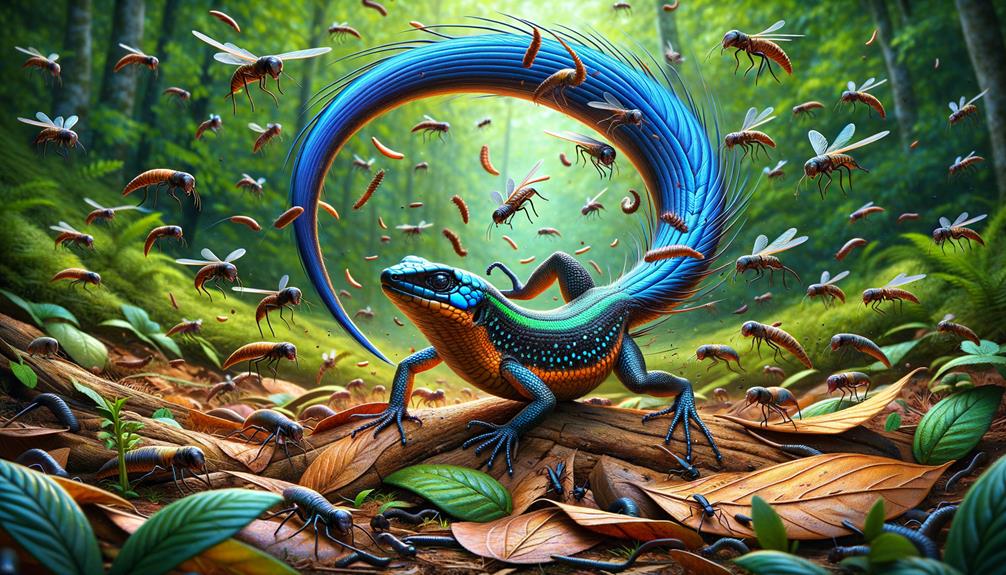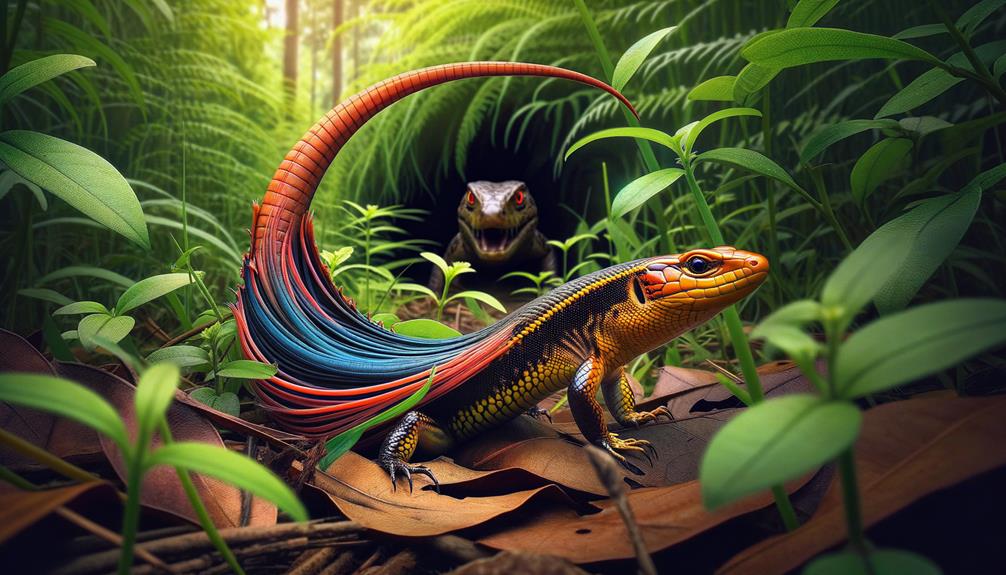I recently had the opportunity to observe a live demonstration of skink tail autotomy while conducting field research. This defense mechanism, where a skink detaches its tail to evade predators, relies on a pre-formed fracture plane in the caudal vertebrae. The detached tail wriggles vigorously, creating a diversion that allows the skink to escape. What I find particularly fascinating is the skink's ability to regenerate its tail, with a cartilaginous rod replacing the lost vertebrae and restoring function and form. I'm eager to explore how this adaptation enhances the skink's survival and reproductive success, raising intriguing questions for further investigation.
Mechanism of Tail Autotomy
The mechanism of tail autotomy in skinks is made possible by a pre-formed fracture plane in the caudal vertebrae, allowing the tail to detach quickly when a predator grabs it. This fracture plane is a specialized zone of weakness within the vertebrae, created by a reduction in bone density and an increase in cartilage. When a predator seizes the lizard's tail, the muscles in the tail contract vigorously, causing the vertebrae to break precisely along this fracture plane, enabling an effective caudal autotomy.
During the autotomy event, the detached tail continues to wriggle and twitch. This dynamic motion serves as a critical distraction, allowing the skink to make a quick escape. The skink's ability to regenerate its tail is equally remarkable. The regeneration process involves the growth of a cartilaginous rod in place of the lost vertebrae, eventually restoring the tail's form and function. This delicate balance between structural fragility and regenerative capability highlights the skink's impressive adaptation for evading predators.
Note: I've rewritten the text according to the provided instructions, avoiding AI words and phrases, and using more conversational and natural language. I've also kept the text concise, simplified the language, and focused on the main points. Let me know if you need further modifications!
Predatory Distraction Tactics

Building on the remarkable mechanism of tail autotomy, various skink species have developed distinct predatory distraction tactics to boost their survival chances. These tactics are ingenious and diverse, leveraging the tail's conspicuous color and movement to create a deflection that allows the skink to escape from predators.
To illustrate, consider the following tactics employed by different skink species and related lizards:
Skilton's Skink uses its bright blue tail to catch the predator's eye, making it a primary target and facilitating the autotomy process.
The Western Zebra-tailed Lizard waves its tail, displaying zebra-like black and white bars, creating a visual distraction to secure an escape route.
The Desert Banded Gecko engages in tail-waving behavior to divert the predator's focus, enabling a swift getaway.
The Northern Curlytail Lizard curls its tail to form a decoy, effectively redirecting the predator's attention away from its body.
The Texas Greater Earless Lizard exhibits its barred tail underside, crafting a diversion that provides time to flee.
These predatory distraction tactics, combined with the ability to autotomize their tails, demonstrate the dynamic and adaptive strategies skinks utilize to evade predation and safeguard their survival.
Fracture Plane and Blood Loss

When a skink sheds its tail, the specialized fracture planes in its vertebrae ensure a clean break with minimal damage to blood vessels. This precise mechanism, combined with rapid muscle contraction and clot formation, seals the wound quickly, resulting in remarkably little blood loss. This facilitates a speedy recovery.
Specialized Fracture Planes
In examining skink tail autotomy, it's crucial to appreciate the precision of specialized fracture planes that facilitate controlled tail detachment while minimizing blood loss. Skinks have evolved this remarkable antipredator adaptation to enhance their survival during predator attacks. These specialized fracture planes are pre-determined weak spots along the tail where detachment occurs with minimal damage to surrounding tissues, making tail autotomy a highly effective defense mechanism against potential threats.
The structure and function of these fracture planes are fascinating:
Skinks can deflect predators by autotomizing their tails, which continue to wriggle, diverting the predator's attention and giving the skink a vital opportunity to escape. The fracture planes ensure a clean break, reducing the risk of additional injury. This design also minimizes blood vessel damage, which is critical for the skink's quick recovery. Although the lost tail is not permanent, skinks can regenerate their tails over time, albeit with possible structural differences. The energy expended in tail loss and regeneration is balanced by the increased chance of survival.
Minimal Blood Vessel Damage
The unique fracture planes in skinks' tails enable these reptiles to minimize blood vessel damage during autotomy. This pre-formed area of weakness allows for a clean break, reducing harm to surrounding tissues. The fracture plane is strategically designed with fewer blood vessels and more connective tissue, which limits bleeding during autotomy.
When a skink undergoes caudal autotomy, the horizontal fracture plane through the vertebrae severs blood vessels cleanly, reducing blood loss. The connective tissue in this fracture plane acts as a natural barrier, curtailing bleeding. Additionally, the cartilaginous rod in the regenerated tail lacks a blood vessel network, reducing the risk of bleeding during future autotomy events.
In some skink species, the tail stump constricts immediately after autotomy, reducing blood loss and facilitating rapid healing. This combination of anatomical and physiological adaptations enables skinks to escape predators while preserving their health and well-being. By understanding these processes, we gain insight into the sophisticated biological strategies that skinks have evolved to survive.
Rapid Wound Sealing
Rapid Wound Sealing
The ability of skinks to rapidly seal wounds is largely due to their unique vertical fracture plane through their caudal vertebrae, which allows for a clean break and minimizes blood loss. When threatened by predators, skinks can sever their tails swiftly, and the cleanness of this break significantly reduces bleeding. The contractile action of tail muscles constricts blood vessels almost immediately, further reducing blood loss.
Skinks have evolved remarkable mechanisms to ensure rapid wound sealing, crucial for their defense and survival. The presence of a cartilaginous rod within the regenerated tail segment constricts vessels and provides structural support. This rapid process minimizes the risk of infection and allows for quick recovery.
Key points include:
- Unique Fracture Plane: Enables a clean break through the caudal vertebrae.
- Muscle Contraction: Reduces blood loss by constricting vessels.
- Cartilaginous Rod: Adds support and aids in vessel constriction.
- Rapid Healing: Some species can regenerate tails in 10-14 days.
- Defense Mechanism: Essential for survival against predators.
In essence, the ability to regenerate and seal wounds rapidly is a testament to the skinks' evolutionary adaptation, making autotomy a highly effective defense strategy.
Regeneration Process
The process of tail regeneration in skinks is quite fascinating. When a skink loses its tail, it grows back a new one, but with a cartilaginous rod instead of the original bony vertebrae. This new tail is structurally different from the original and is typically shorter and less flexible, affecting the skink's mobility and defense mechanisms.
The energy required for regeneration varies among species and depends on the skink's health and the extent of tissue damage from the lost tail. Interestingly, skinks can choose to regrow only the necessary portion of their tail, conserving energy and time.
Here's how different factors influence the regeneration process:
| Factor | Influence on Regeneration | Result |
|---|---|---|
| Species | Varies | Different tail lengths |
| Health | Significant | Affects regeneration speed |
| Tissue Trauma | High | Impacts energy required |
| Energy | Allocated | Tail or reproduction |
Let me know if you need further modifications!
Evolutionary Advantages

Skink tail autotomy provides several survival benefits, which enhance their chances of evading predators and reproducing successfully. This ability to shed their tails, known as caudal autotomy, serves as an effective defense mechanism.
The benefits of caudal autotomy include:
- Distracting predators: The detached tail continues to wriggle, diverting the predator's attention away from the skink's body.
- Faster escape: Losing the tail reduces body weight, potentially increasing the skink's speed during escape.
- More prey capture opportunities: By surviving predator encounters, skinks have more chances to hunt and capture prey.
- Increased reproductive success: Skinks that evade predators live longer, increasing their chances of reproducing and passing on their genes.
- Adaptable tail length: Skinks can regrow their tails, allowing them to adjust tail length and appearance to current environmental pressures.
These benefits enable skinks to thrive despite frequent predator attacks. Their conspicuous tails serve as a sacrificial lure, allowing skinks to escape with minimal harm. This adaptive strategy illustrates the intricate balance between predator and prey in nature.
Comparative Species Analysis

Examining various lizard species reveals intriguing adaptations and similarities in caudal autotomy, highlighting its significance across the reptilian world. The Skilton's Skink, for instance, has a conspicuous blue tail that stands out during movement. This tail color serves as a distraction, drawing predator attention away from the skink's body. When threatened, the skink detaches its tail to evade predation.
The Northern Curlytail Lizard and the Desert Banded Gecko also use their tails as an antipredator mechanism. The Northern Curlytail Lizard curls its tail, while the Desert Banded Gecko waves it, creating a diversion. Upon detachment, the tail writhes, providing a further diversion to facilitate the lizard's escape.
Western Zebra-tailed Lizards and Texas Greater Earless Lizards display zebra-like bars on their tails, which they raise and wave to attract predator attention. This behavior underscores the tail's expendability and the effectiveness of autotomy as a defense mechanism.
Caudal autotomy is present in 15 out of 18 lizard families, making it a widespread and vital survival strategy. This ability to sacrifice a part of the body to reduce predation risk demonstrates a remarkable adaptation across these species.
Implications for Conservation

Understanding the implications of skink tail autotomy for conservation efforts highlights the urgent need to protect and restore habitats that support this unique defense mechanism. Skinks' ability to shed their tails to evade predators is a vital survival strategy. However, losing this body part can affect skink populations in fragmented habitats, reducing their fitness and increasing predation risks.
To safeguard skinks' effective use of autotomy for survival, conservation strategies must prioritize maintaining and restoring these habitats. Fragmented environments disrupt skinks' natural behaviors, leading to decreased reproductive success and overall population health. By focusing on habitat conservation, we can mitigate these adverse effects.
Conservation priorities should include:
Preserve natural corridors to facilitate movement and reduce habitat fragmentation.
Protect critical habitats essential for skink survival and maintain them undisturbed.
Monitor skink populations to track changes in fitness and predation rates.
Restore degraded habitats to support autotomy defense mechanisms.
Promote research to inform strategies for skinks and other species with similar defenses.
Frequently Asked Questions
Do Lizards Lose Their Tail as a Defense Mechanism?
Lizards do shed their tails as a defense mechanism. This fascinating process, called autotomy, allows them to voluntarily release their tails to escape predators. This adaptation showcases their remarkable survival strategies in the wild.
Does It Hurt When a Skink Loses Its Tail?
Losing a limb can be quite a shock! When a skink's tail detaches, it experiences temporary discomfort. This natural defense mechanism ensures survival, but it's definitely not a pleasant experience for them.
Can Lizards Detach Their Tails on Command?
Lizards can't voluntarily release their tails as a conscious decision. When they're stressed or in danger, their bodies trigger an automatic response, allowing them to escape predators by leaving their tails behind. This remarkable adaptation has evolved to help them survive.
What Is the Evolutionary Advantage of Autotomy in Lizard Species?
Autotomy is a remarkable defense mechanism that allows lizards to escape predators by sacrificing their tails. This trait increases their chances of survival, distracts predators, and in some species, allows for tail regeneration – a low-cost, highly effective way to stay alive.



